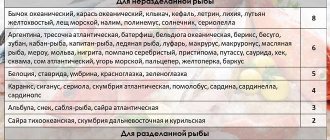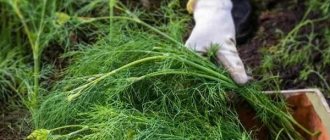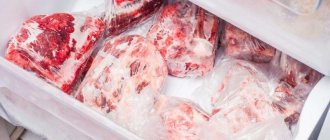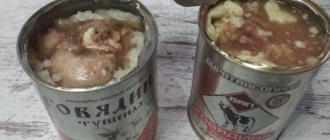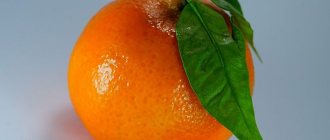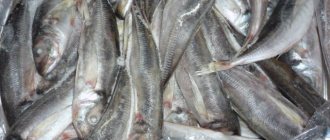§ 7. Requirements for the quality of fish dishes. Shelf life
The quality of finished fish dishes is assessed by the following indicators: compliance with the recipe; correct fish preparation, slicing and breading; compliance with the rules of heat treatment and bringing fish to readiness; taste and smell of the prepared dish; appearance; suitability of the side dish and sauce for the given dish.
Boiled fish is served in one portion with bones, with skin without bones, and sturgeon - with skin without cartilage or without skin. The fish must be cooked, but completely retain its shape. The color, taste and smell must correspond to the type of fish and the roots and spices used during cooking. Garnish - boiled potatoes, turned into barrels or picked up into medium-sized whole tubers, placed next to the fish, drizzled with oil and sprinkled with herbs. The sauce is served separately in a gravy boat or poured over the fish.
Poached fish is served in boneless portions, with or without skin. Sturgeon fish - without cartilage and preferably without skin. Small fish - in their entirety. The fish must be cooked and completely retain its shape. Clots of coagulated protein are allowed on the surface of poached fish, so to improve the appearance of the dish, the fish is poured with sauce and decorated with lemon, mushrooms, and crabs. The side dish, as for boiled fish, is placed side by side or served separately. The fish is heated in the sauce before serving.
Fried fish is served in one portion with skin and bones, with skin without bones, without skin and bones. Sturgeon - without cartilage, with or without skin. Small fish - whole, with a well-cleaned abdominal cavity. The fish must maintain its shape. Its surface should be covered with an even crispy crust from golden to light brown in color, while a slight lag in the breading of the fried fish is allowed. The consistency is soft, juicy, the meat is easily separated with a fork, but not flabby. The taste of fish is specific; no foreign taste, smell of fish and fat. The products are not burnt, not over-salted. The taste and smell of overcooked deep fat are unacceptable. Whole fish fried is cut into portions at right angles. The pieces must retain their shape, and their surface should not be weathered. The fish is placed on a plate next to the side dish, the sauce is served separately in a gravy boat or oil is poured over the fish.
Serve the fish in the dough in 6-8 pieces. The fish should be well fried but juicy. The dough is porous and fluffy. The color is light golden. For deep-fried fish, an unacceptable defect is the dark color of the fried fish.
Baked fish dishes are prepared from fish cut into portions without bones, with or without skin. Whole fish - bream, tench, crucian carp - are baked with bones. There should be a browned crust on the surface of the dish. The sauce should thicken but not dry out. The dish is juicy, the fish and side dish are not burnt or dry to the dishes.
Dishes made from fish cutlet mass must retain their shape, have no cracks, and consist of a homogeneous, thoroughly crushed and mixed mass. The surface of fried products is covered with a well-fried crust. The color on the cut ranges from white to gray, the products are juicy and loose. Unacceptable defects are the irregular shape of the product, the rolling of the breading inside the product, the presence of foreign odors, the taste of sour bread, burnt crusts, etc. When releasing, the product is placed on a plate, the side dish is placed on the side, only the meatballs and meatballs are poured with sauce, the sauce is added to the rest of the products on the side.
Boiled and poached fish is stored on a steam table in broth at a temperature of 60-70 °C for no more than 30 minutes before release. Fried fish is stored on a stove or steam table for no more than 2-3 hours, after which it is cooled to 6-8 ° C and stored at the same temperature for up to 12 hours. Before serving, the fish is heated in an oven at a temperature of up to 90 ° C or on the stove with the main method, after which they are sold within 1 hour. Fried and baked fish dishes are prepared according to demand.
studfiles.net
Basic fried fish
Amount of products per serving weighing 255 g with butter or 280 g with sauce: fish - 148–238 g (according to the standards of the collection of recipes), wheat flour - 6 g, vegetable oil or lard - 6 g, butter - 7 g or sauce – 50 g, side dish – 150 g.
Dried whole fish or portioned pieces are sprinkled with salt and pepper, breaded in flour, placed in a frying pan or baking sheet heated with fat, skin side down, and fried on both sides until a crispy golden crust forms for 5-10 minutes at a temperature of 140-160 °C. The fish is fried in the oven until fully cooked for 5–7 minutes at a temperature of 250 °C. Total frying time is 10–20 minutes. By the end of frying, the fish warms up inside to 85–90 °C. The readiness of fish is determined by the presence of small air bubbles on its surface. Fried fish is released immediately after heat treatment.
A side dish is placed on a heated portion dish or plate: fried or boiled potatoes or mashed potatoes, fried fish next to it, poured over with melted butter. Separately, the fish is served with tomato, red, sour cream sauce or mayonnaise with gherkins. The dish is decorated with parsley and sometimes lemon slices. Fried fish is also garnished with stewed cabbage, buckwheat porridge, fried zucchini, eggplant, and tomatoes.
Deep fried fish
Amount of products per serving weighing 330 g with sauce or 305 g with mayonnaise: pike perch - 192 g, or catfish - 198 g, or sea bass - 192 g, or navaga - 111 g, or mackerel - 107 g, wheat flour - 6 g, egg – 1/7 pcs., crackers – 15 g, fat – 10 g, butter – 7 g, side dish – 150 g, tomato sauce – 75 g or mayonnaise sauce – 50 g.
The prepared semi-finished product (whole fish or portioned pieces) is placed in deep fat, heated to a temperature of 160–180 °C. The fish is lowered using a slotted spoon, carefully so as not to cause splashing of fat and fried for 5-10 minutes until a golden crust forms on the surface, then taken out, allowed to drain off the fat, placed in a frying pan and finished frying in the oven.
When leaving, a side dish is placed on a heated portioned dish or plate: boiled potatoes or french fries, fish is placed next to it, which is poured with melted butter, garnished with a slice of lemon and deep-fried parsley. Mayonnaise sauce with gherkins or tomato sauce is served in a gravy boat.
Fish fried in dough
Amount of products per serving weighing 225 g: pike perch – 140 g, citric acid – 0.2 g, vegetable oil – 4 g, parsley – 2 g, wheat flour – 30 g, egg – 3/4 pcs., milk – 30 , fat – 15 g, sauce – 75 g.
After marinating, pieces of fish are pricked with a fork or a chef's needle, immersed in batter, then dipped in boiling fat and fried for 3–5 minutes. The finished fried fish floats to the surface of the fryer, it is removed with a slotted spoon, and transferred to a colander to drain the fat.
The fish is placed on a dish or plate covered with a paper napkin, 6-8 pieces each, giving them the shape of a pyramid. The dish is decorated with parsley and lemon slices. Mayonnaise sauce with gherkins or tomato sauce is served separately. Fish can also be served with French fries. When preparing batter, use water or beer instead of milk. The fish is sometimes cut into cubes.
The fish should be well cooked but still juicy. The dough is porous and fluffy, the color is light golden. For deep-fried fish, an unacceptable defect is the dark color of the fried fish.
studfiles.net
Boiled fish
For cooking, fish of all types is used, which when boiled has good taste. The fish is cooked in portions, whole and in sections. Cook in portions. Portion pieces are cut into fillets with skin and bones, fillets with skin without bones and round pieces. 2...3 cuts are made on the skin so that the fish does not become deformed during heat treatment. The prepared semi-finished products are placed in deep baking trays or in a wide low pan in one row, skin side up, and filled with hot water so that it is 1…2 cm above the level of the fish. Add pieces of raw carrots, parsley and onions, salt, bay leaves and peppercorns, bring to a boil and cook the fish without boiling (temperature 85...90°C) for 5...10 minutes, remove the coagulated whites from the surface of the fish. Readiness is determined by appearance, by piercing the thickest part of the fish. In table Table 10.1 provides data on the duration of heat treatment of various types of fish, crayfish and non-fish seafood.
Fish that has a pleasant smell is boiled without adding bay leaves, pepper, or spicy roots. Cod, catfish, flounder and other sea fish with a sharp, specific odor are boiled in a previously prepared spicy broth. To do this, add roots, onions and spices to the water, boil for 5...7 minutes, after which the fish is boiled. You can add cucumber pickle or pickled cucumber peels. Per serving use 3 g of salt, 0.01 g of black pepper, 0.01 g of bay leaf. To preserve the shape, consistency and color of the fish during the cooking process, add vinegar (10 g per 1 liter of water). Boiled fish is stored in broth and used within 30...40 minutes.
Cooking whole carcasses. They cook pike perch, trout, salmon, white fish, pike, nelma, and sterlet. The processed fish, tied with twine, is placed on the grate of the fish pot, belly down. Fill with cold water so that it is 2 cm above the level of the fish. Cold water is used to ensure that the fish is evenly heated during the cooking process, and the outer and inner muscle layers are simultaneously cooked. Depending on the type of fish, roots and spices are added. The fish is brought to a boil and cooked almost without boiling so that the movement of water is barely noticeable. Remove foam from the surface. Cooking time for large fish is 1...1.5 hours, for small fish - 30...45 minutes. The readiness of the fish is determined by piercing the thickest part with a chef's needle. Clear juice should be released at the puncture site. The cooked fish is taken out along with the grill, the protein clots are washed off, the twine is removed and placed on a heated dish, garnished with boiled potatoes, cauliflower, mushrooms, crayfish tails, and crabs. Decorate with lemon and herbs. Divide into portions with a fish spatula, serve the sauce separately or pour it over the fish after dividing into portions. Boiled whole fish is used cold for banquet and exhibition dishes.
Cooking fish in sections. Links of sturgeon fish (stellate sturgeon, sturgeon, large pieces of beluga - 2...3 kg) are placed on the grate of a fish boiler or a special device for boiling links. Place them skin side down, fill them with cold water and cook them in the same way as whole fish. To preserve the taste and aroma of sturgeon fish, when cooking, spices and roots are added in small quantities. The cooking time depends on the type of fish and the size of the links and ranges from 45 minutes to 1 hour or 1.5...2.5 hours. The readiness of the links is determined in the same way as for whole fish. The boiling rate of sturgeon fish is 15%. Boiled sturgeon fish is cooled in the broth, protein clots are washed off with broth, removed from cartilage, and placed on trays. Chilled sturgeon fish links are cut into portions and used for cold dishes and snacks. For hot dishes, portioned pieces are heated in broth to a temperature of 70 °C. The broths obtained by cooking fish are filtered and used to prepare sauces and first courses.
Boiled fish. Pink salmon or chum salmon 181, or pike perch 192, or spotted catfish 146, or Azov-Black Sea mackerel 176, or black halibut 192, or ocean mackerel 205, or eelpout 132; from semi-finished products: grenadier 130 or Far Eastern mackerel 132, carrots 4, onions 4, parsley (root) 3, side dish 150, sauce 50. Yield: 300.
The fish is cooked in portions and stored in hot broth for no more than 30 minutes until it is released. When leaving, put a side dish on a heated plate: boiled potatoes, mashed potatoes or vegetable stew, and place fish skin side up next to it. The side dish is poured with melted butter, the fish with broth. Polish, white main, tomato, sour cream sauce is served separately in a gravy boat, or the sauce is poured over the fish.
studfiles.net
Sanitary requirements for food distribution and food temperature
Before the start of distribution, ready-made dishes are checked by the cook, and then by the rejection commission, which includes: the production manager (or his deputy), the product manufacturer, a sanitary worker or a member of the sanitary post, and in industrial enterprises, in the canteens of educational institutions, also a public inspector. The results of the rejection are recorded in the rejection journal. Rejection is carried out on each new batch of dishes and culinary products before they are released to the consumer.
The temperature of the dishes served to the consumer must be: for the first - not lower than 75 ° C, for the second - not lower than 65 ° C; Cold food and drinks are served at temperatures between. 7 to 14 °C.
FISH DISHES
Crackers are a semi-finished product in the form of thin slices (noodles). Before use, crackers are deep-fried at a temperature of 150–180°C to produce potato brushwood, which is used as a side dish for meat and fish dishes.
Semi-finished vegetables and ready-made meals are supplied frozen. When using such dishes, it is necessary to strictly observe sanitary rules, preventing their secondary freezing. Reheat food immediately before serving. Before heating, the product is removed from its packaging. To do this, the blocks are placed on tables or racks for 1–2 hours at a temperature of 15–18°C. Heat the dishes on the surface of the stove, in an oven or in a microwave oven. Second courses and side dishes are heated to a temperature of 85 ° C in the thickness of the product; reheating is not allowed.
Potato cutlets come packaged in 2 pieces. in varnished cellophane or 6 pcs. in boxes. Before leaving, the cutlets, without defrosting, are placed on a heated baking sheet with fat and fried on both sides until golden brown.
Frozen stewed cabbage arrives in blocks. Before use, blocks of stewed cabbage are placed in a saucepan or deep baking sheet, broth or water is added (100 g per 1 kg of cabbage), covered with a lid and placed in the oven for 30–40 minutes, then heated on the stove for 8–10 minutes.
Frozen stuffed cabbage rolls and peppers are delivered in blocks. Before use, the blocks are placed in a saucepan or deep baking sheet in one row, broth or water is added at the rate of 40 g per serving, closed with a lid and placed in an oven at a temperature of 220–250 ° C for 30–40 minutes, then continued heating on the stove for 8–10 minutes at low boil.
Carrots in milk sauce, beets in milk sauce, frozen vegetable stew
they walk in blocks. Before use, the blocks are placed in a saucepan or deep baking sheet, covered with a lid, and placed in an oven for 30–40 minutes at a temperature of 180–200°C. Then continue heating on the stove for 8–10 minutes with gentle stirring.
Chapter VI
Hot fish dishes occupy a significant place in the range of dishes prepared in catering establishments. Fish dishes contain a lot of proteins, which are easier to digest than meat proteins. The muscle tissue of fish is softer and more tender compared to meat, since collagen in the connective tissue layers of fish is less resistant to heat and quickly turns into gluten.
Depending on the types of fish used, fish dishes contain different amounts of fat. The greatest amount of fat contains dishes prepared from sturgeon, salmon, herring, mullet, halibut, and flounder. Dishes made from cod, pike, perch, and carp are considered low-fat. You need to know the fat content in order to choose the appropriate side dish and sauce for your dishes.
The distinctive properties of fish fat include its ability to easily melt and remain in liquid form at fairly low temperatures, so it is absorbed much better than beef or lamb fat. Thanks to this, fish dishes are also used cold. Valuable unsaturated fatty acids enter the human body with fish oil. In the tissues of most fish, fat is distributed unevenly. The greatest culinary value is fish with a uniform distribution of fat in the tissues (salmon, sturgeon). The presence of fat gives fish dishes higher calorie content and better taste.
Fish dishes are rich in minerals (sodium, potassium, phosphorus, iodine, sulfur, chlorine, iron, copper, etc.), especially dishes prepared from sea fish. Fish contains vitamins D and A in large quantities, and some types of fish contain vitamins B1 and B2. Among the extractive substances of fish there are substances that stimulate appetite.
Various types of fish differ in taste and nutritional content. Therefore, when preparing fish dishes, it is necessary to choose a cooking method that allows you not only to prepare the dish tasty, but also to preserve valuable nutrients in it. Depending on the methods of heat treatment, fish dishes are divided into boiled, poached, fried in the main method, fried in a large amount of fat, stewed, baked.
During the process of heat treatment, fish undergoes complex physical and chemical changes. When boiling and frying fish, protein coagulation occurs, collagen protein, fat, vitamins and extractives change, water is released, and the weight and volume of the fish changes. As a result of heat treatment, the digestibility of fish increases, tissue fibers soften and bacteria that can be contaminated with semi-finished fish products die. Sturgeon fish can sometimes contain spores of pathogenic bacteria and the harmful substances they produce - toxins. Therefore, it is necessary to carefully monitor the thermal process and complete preparation of the fish.
Fish contains albumin proteins, soluble in water, globulins, soluble in salt solutions, as well as complex phosphorus-containing proteins, which begin to coagulate (denature) when heated to 35°C. This process ends when it reaches 65°C. Curled proteins in the form of light foam appear on the surface when cooking fish. Fish contains from 1.6 to 5.1% collagen, of which its connective tissue almost entirely consists. Fish collagen is less stable than meat collagen. At a temperature of 40 ° C, it coagulates and transforms into glutin, which is a sticky substance that is easily soluble in hot water, due to which saturated fish broths form a jelly when they solidify. Fish gluten can retain water to a greater extent than meat gluten, so when cooked, fish loses less weight than meat. When cooking fish, the myofibril proteins become denser, resulting in a decrease in the volume and weight of the fish.
The change in fish mass is 18–20%, i.e. half that of cattle meat. The main part of these losses is water separated by proteins. When boiling and frying, the weight loss is almost the same, the difference is 1–2% in one direction or another. The weight of breaded fish pieces changes less than unbreaded ones. When frying in the field of infrared radiation, weight loss is reduced by reducing the heat treatment time.
The total amount of soluble substances passing from fish into the broth is 1.5–2% of its mass, including extractive and mineral substances – 0.3–0.5%. When boiled, extractive substances turn into a decoction, giving broths a good taste and the ability to stimulate appetite.
The fat contained in the fish is partially lost during cooking, floating to the surface of the broth and emulsifying. Since cooking and poaching are carried out without boiling (at 85–90°C), the amount of emulsified fat in the broth is insignificant.
Hot fish dishes are prepared in the sauce shop. To do this, use pots, stewpans, elongated fish kettles in which fish are boiled and poached, baking sheets, frying pans, fryers for frying, portioned frying pans for baking, various equipment in the form of spatulas, skimmers, colanders, chef's needles, etc.
Fish dishes are served in heated small plates, round metal or oval dishes, and portioned frying pans. The temperature for serving hot dishes must be at least 65 °C. Amount of fish per serving: 75, 100 or 125 g.
§ 1. Boiled fish
All kinds of fish are used for cooking: cod, flounder, catfish, perch, pike perch, catfish, pike, coal and ice fish, merou, notothenia, sturgeon.
For cooking in portioned pieces, use fillets with skin and bones, fillets with skin without bones, and round pieces. The prepared fish is placed in deep baking trays or fish kettles in one row, skin side up, and poured with hot water so that it is 2–3 cm deep.
studfiles.net
Tips and tricks
Catering enterprises, when selling finished products, are required to comply with basic rules. The serving temperature for main courses requires careful attention. Due to the short shelf life of ready-made dishes, they are prepared for the table immediately before serving.
The remaining products must be quickly cooled and stored in the refrigerator. Before the next serving, the dish may be heated to the required temperature. When storing it, it is important to mark it to indicate the cooking time and date.
Hot meat and fish dishes are prepared immediately before serving. This will help maintain their juiciness and excellent flavor. Cold desserts are prepared in advance, allowing the necessary time for soaking, infusion, and hardening. Hot sweet dishes can be stored in the form of preparations, which are brought to readiness before serving.
Fish dishes Changes that occur during cooking of fish
Fish dishes are a source of complete, easily digestible protein. The connective tissue collagen of fish is less resistant to heat, quickly turns into glutin, muscle tissue as a result of heat treatment becomes looser, softer, easier to soak in digestive juices, and is absorbed faster and better.
The nutritional value of fish dishes depends on the type of fish and fat content. You need to know the fat content in order to choose the appropriate side dish and sauce for your dishes.
Fish fat is fusible and at ordinary temperatures is in a liquid state. This makes it easier to digest and allows you to eat fish not only hot, but also cold. Valuable unsaturated fatty acids enter the human body with fish oil. In the tissues of most fish, fat is distributed unevenly. The greatest culinary value is fish with a uniform distribution of fat in the tissues (salmon, sturgeon). The presence of fat gives fish dishes higher calorie content and better taste. Fish dishes are rich in minerals (sodium, potassium, phosphorus, iodine, sulfur, chlorine, iron, copper, etc.), especially dishes prepared from sea fish. Fish contains vitamins A and D in large quantities, and some types of fish contain vitamins B | and B2. Among the extractive substances of fish there are substances that stimulate appetite.
Various types of fish differ in taste and nutritional content. Therefore, when preparing fish dishes, it is necessary to choose a cooking method that allows you not only to prepare the dish tasty, but also to preserve valuable nutrients in it. Depending on the methods of heat treatment, fish dishes are divided into boiled, poached, fried in the main method, fried in a large amount of fat, stewed, baked.
During the heat treatment process, fish undergoes complex physical and chemical changes. When boiling and frying fish, protein coagulation occurs, collagen protein, fat, vitamins and extractives change, water is released, and the weight and volume of the fish changes. As a result of heat treatment, the digestibility of fish increases, tissue fibers soften and bacteria that can be contaminated with semi-finished fish products die.
Sturgeon fish can sometimes contain spores of pathogenic bacteria and the harmful substances they produce - toxins. Therefore, it is necessary to carefully monitor the thermal process and complete preparation of the fish. Fish contains albumin proteins, soluble in water, globulins, soluble in salt solutions, as well as complex phosphorus-containing proteins, which when heated to a temperature of 35 ° C begin to coagulate (denature). This process ends when the temperature reaches 65 °C. Curled proteins in the form of light foam appear on the surface when cooking fish. Fish contains collagen, which is almost entirely the connective tissue. Fish collagen is less stable than meat collagen. At a temperature of 40 ° C, it coagulates and transforms into glutin, which is a sticky substance that is easily soluble in hot water, due to which saturated fish broths form a jelly when they solidify. Fish gluten can retain water to a greater extent than meat gluten, so when cooked, fish loses less weight than meat. When cooking fish, the myofibril proteins become denser, resulting in a decrease in the volume and weight of the fish. The change in fish mass is 18...20%, i.e. half that of cattle meat. The main part of these losses is water separated by proteins. Soluble nutrients pass into the broth (minerals, extractives, vitamins). When boiled, extractive substances turn into a decoction, giving broths a good taste and the ability to stimulate appetite. The fat contained in the fish is partially lost during cooking, floating to the surface of the broth and emulsifying. Since cooking and poaching are carried out without boiling (at a temperature of 85...90°C), the amount of emulsified fat in the broth is insignificant. Hot fish dishes are prepared in the sauce shop. To do this, use pots, stewpans, elongated fish kettles in which fish are cooked and poached, baking sheets, frying pans, deep fryers for frying, portioned frying pans for baking, various equipment in the form of spatulas, colanders, chef's needles, etc.
Fish dishes are served on heated small plates, round metal or oval dishes, and portioned frying pans. The temperature for serving hot dishes must be at least 65 °C. Amount of fish per serving - 75, 100 or 125 g.
studfiles.net
Requirements for serving main courses
Before bringing main courses to the table, used dishes and cutlery are removed (washed). If a common dish is served and then divided into portions, take it out in a large container. Place heated dinner plates in front of the guests and divide the dish into portions. The same rules apply for serving side dishes. The pre-prepared dish is brought out in its entirety for display, after which it is divided into portions in the kitchen.
Dishes in frying pans are placed on warm snack plates, directly in front of the guests. Additionally, hot sauces are served in metal sauce boats, or chilled in small plates or special bowls. The requirements for serving second hot courses include compliance with the temperature regime, which may vary, depending on the recipe of the dish, the ingredients included in it and the classification of the establishment.
